Whether you like basil in pesto or picked fresh from the garden, you can’t deny that basil is arguably one of the most versatile, delicious herbs in existence. Basil (Ocimum basilicum) is popular amongst most home gardeners as being an easy herb to grow, both in the garden or in a pot on the kitchen windowsill. However, if like me, you find your basil’s previously luscious green leaves are beginning to turn yellow, you’ll want to know why and how to fix it. Read on to find out.
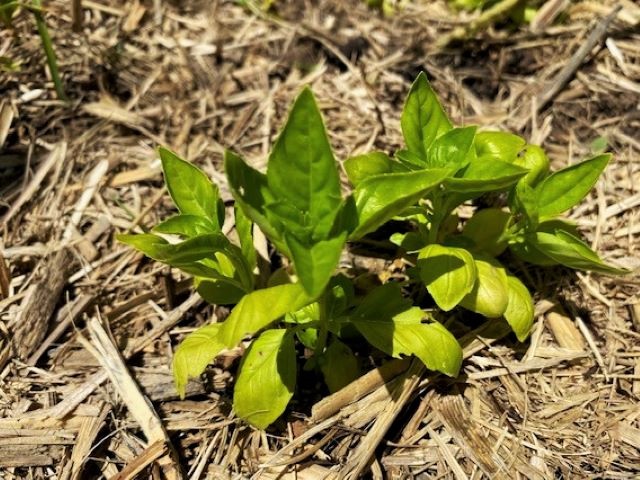
Related: 7 Basil Pests (And How to Get Rid of Them!)
Table of Contents
Why Are My Basil Leaves Yellow?
The yellowing of basil leaves is commonly caused by cool temperatures, insufficient nutrients, excessive fertilizer, overwatering, insufficient lighting, overcrowding of plants, or aphids.
Let’s further explore some of the possible causes and solutions for your basil’s yellowing leaf color.
1. Cool Temperatures
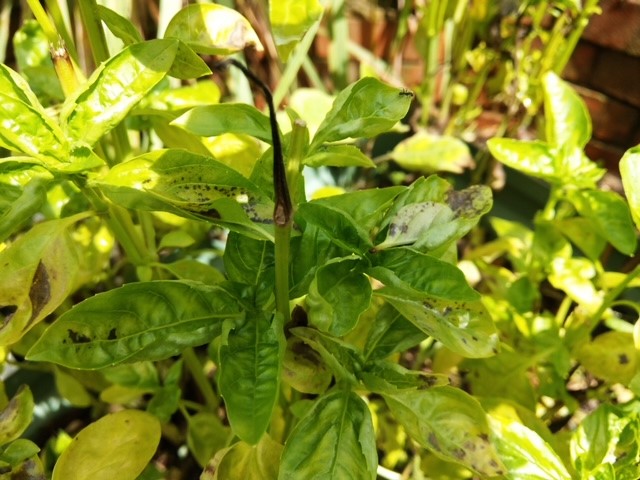
The tasty green leaves of a basil plant are sensitive to cooler temperatures. Basil grows best at temperatures between 65°F-85°F (18-29°C). When temperatures begin to descend below 60°F (15°C), the leaves of your basil plant will begin to discolor. Below 50°F (10°C) is just too cold to grow basil and these temperatures will turn the leaves black and lead to plant death.
The yellowing of your basil plant’s leaves, especially towards the end of the growing season, is a common occurrence as the temperatures begin to decline.
Basil is an annual plant, meaning that it dies after a single season and needs to be replanted every year. Sowing your basil seeds too early in the season will expose your young basil plants to cooler temperatures, resulting in yellowed leaves.
I like to germinate basil seedlings indoors for the first 4 weeks of their growth before transplanting them outdoors into warmer soil. At transplanting time, the temperature of the soil should be at least 60°F-70°F (15-21°C). This will protect your basil seedlings from getting cold feet, I mean, leaves.
Using a grow light and a seedling heat mat while growing indoors is an effective method of protecting my basil plants against cooler temperatures. This propagation kit here also includes a grow light and makes sprouting basil seeds really easy.
2. Insufficient Nutrients
Yellow leaves on your basil plant during the warmer summer months could be a sign of a lack of nutrients in the soil (nutrient deficiency). Watering your basil plants from time to time is not enough, their green leaves require additional nutrients to grow.
Basil grows best in soil with pH levels of between 5.5-7. If the pH level of your soil is too high or too low, your basil plants will not be able to effectively absorb any nutrients that are added to the soil. You can test the pH and nutrient levels in your soil with a soil testing gauge like this one.
Prepare your soil beforehand so you give your basil plants a head start. I always include 1-2 inches of homemade compost and add an organic herb fertilizer like this one.
If you’re growing basil in a pot or container, I recommend adding two parts potting soil and one part compost into your pot. Don’t forget to give your basil plants additional fertilizer which is otherwise depleted at a faster rate in pots due to the additional watering that’s required.
3. Excessive Fertilizer
Nitrogen and minerals in your fertilizer are essential for the growth of your basil plants. But when there is an excessive amount of fertilizer, or the wrong type of fertilizer is used, it can shock and burn your basil plant. As a result, the leaves of your basil plant can turn yellow.
If you suspect over-fertilization is the reason your basil plant leaves are yellow, there are a few steps to follow to prevent further damage.
Firstly, you will need to immediately stop fertilizing your basil plants and remove any visible fertilizer from the soil.
Flush your basil plants system by irrigating the roots with clean, neutral water which will remove any lingering fertilizer.
Remove your basil plant from direct sunlight and place it in a cooler, shaded area. This will decrease the amount of nutrients the plant’s root system will absorb.
Additionally, you can use a few inches of mulch around the base of your basil plant as this will keep the roots cool and reduce plant stress.
4. Overwatering
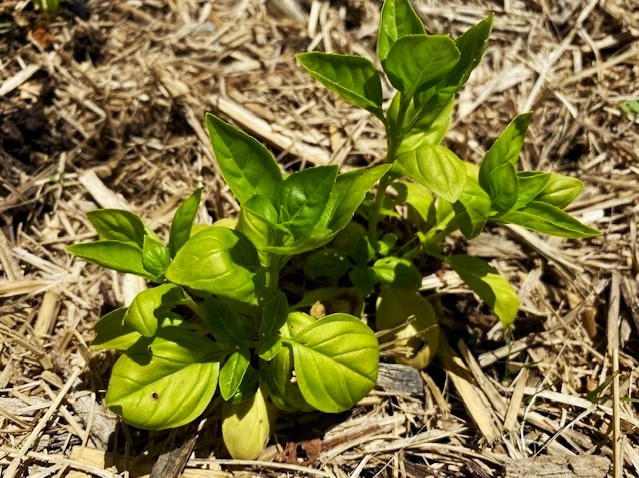
Overwatering your basil plants and growing them in soggy soil will lead to the development of root rot. This fungal disease prevents your bail plants from absorbing nutrients from the soil. Yellowing leaves on your basil plant are one of the first tell-tale signs of root rot.
Overwatering is a common problem associated with container-grown (or pot-grown) basil plants. However, basil plants that are grown in a container or pot will dry out quicker than those that are grown in the garden, which means they will require more watering.
As a general guide, basil needs to be watered when the top layers of soil (1-2 inches) have dried out. You can test this by gently scratching the surface of the soil with your finger. If the soil is dry, give your basil plant some water. If the soil is moist then hold off watering for a few days.
Your basil plant’s watering needs will vary with the climate you’re growing in. In very warm weather, basil will need watering daily, while in milder weather, basil may only require water once every few days. You can also use a watering gauge like this one to test the moister levels in your soil.
If you are growing basil in a container or pot, it’s essential to use a container (or pot) with drainage holes in the bottom of it. Also, always check the drainage holes to make sure that they are not clogged by mulch, soil or stones.
A quick fix to solving your overwatering problem is to simply stop watering your basil plant and allow the soil to dry out somewhat before watering again. By doing this, you are making sure that your basil is indeed thirsty and in need of water. If you find you are still having trouble determining when to water your basil plants, you can always use the watering gauge mentioned above to take an accurate reading.
I’ve experienced basil plants yellowing due to too much rainfall. The soil became waterlogged as the water couldn’t drain away. In this case, you can improve soil drainage by ensuring the soil has adequate compost. Or for climates with high rainfall, consider planting basil in a raised garden bed which is a great option for creating free-draining soil.
5. Insufficient Lighting
A healthy basil plant requires six to eight hours of bright sunlight per day. Anything less than four to five hours of sunlight per day will cause the leaves of your basil plant to turn yellow and possibly drop off the plant.
Low levels of sunlight decrease the rate of photosynthesis in a basil plant’s leaves and cause the leaves to discolor. Once a leaf has turned yellow it will never be able to turn green again.
If you are growing basil plants indoors, this can be challenging. I recommend placing your basil plant on a sunny south-facing windowsill which can be a solution to your sunlight crisis. Alternatively, you can use an indoor grow light in order to provide your basil plants with their lighting needs.
Basil loves to sunbathe- outdoor-grown basil should be planted in the sunniest area of your garden. If there are some surrounding trees or plants, you may need to trim back their branches to allow more sunlight to reach your basil plants.
6. Overcrowding
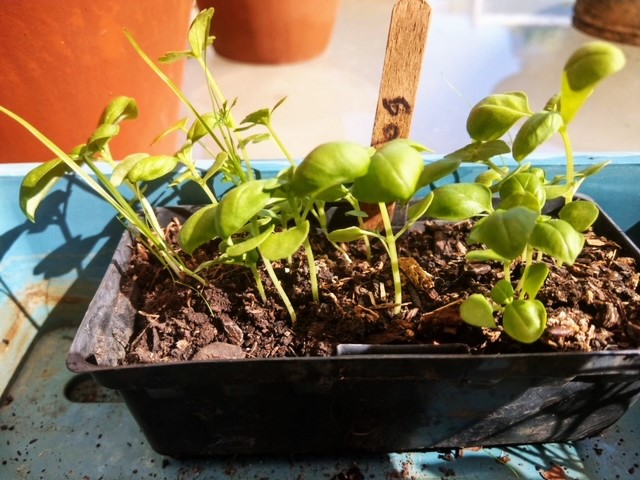
Sometimes it may seem easier to throw a bunch of tiny basil seeds into some soil in the hopes that a few will sprout. However, this method of sowing seeds may cause problems when they all start to grow together! Basil seedlings are often also sold in clumps in seed trays. Initially, this will be fine, until they begin to compete.
Seedlings will compete for moisture, nutrients, sunlight, and space which will lead to them starving and strangling each other, causing basil leaves to turn yellow.
Basil seedlings need to be spaced eight to twelve inches apart from each other, as they spread their roots and absorb nutrients from the surrounding soil. When planting basil seedlings, you can try using seedling trays like this one for germinating each basil plant in its own tray slot.
7. Aphids
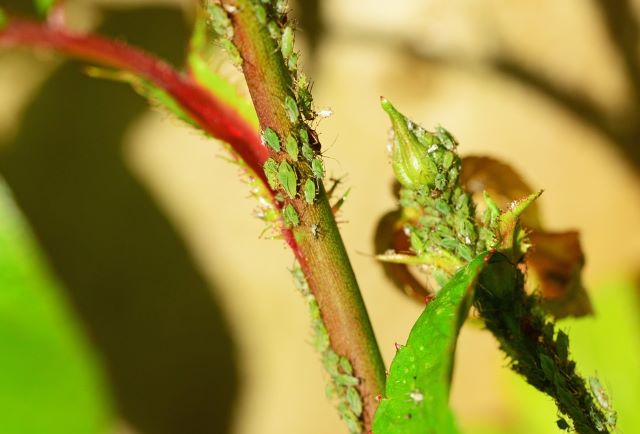
Aphids can’t resist tasty, lush, green basil plants. They enjoy sucking the sap from plants’ leaves, causing them to turn yellow. Take a closer look at the leaves of your basil plant, if you notice a cluster of green insects on the undersides of the leaves, these are most probably aphids.
An aphid infestation, if left unattended, will spread amongst all of your plants, weakening them and leaving them susceptible to disease.
There are several ways to remove and prevent aphids from further infecting your basil plants.
A spray of water can help dislodge aphids from basil plants. For a more stubborn aphid infestation, I would use insecticidal soap. And should the problem still persist, one of my favorite organic pest treatments is horticultural neem oil.
Aphids have natural enemies such as ladybugs and lacewings. Introducing these natural predators into your garden will prevent aphids from returning in the future. The best way to do this is by planting a diverse garden with flowering plants and eliminating the use of chemicals in your herb garden.
Further reading:
